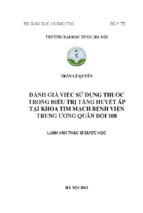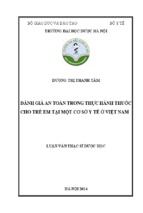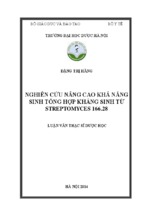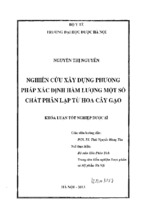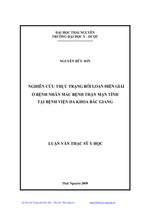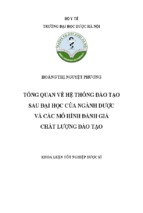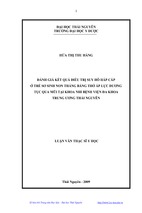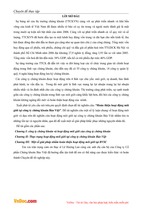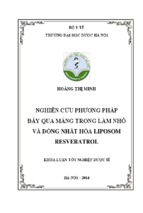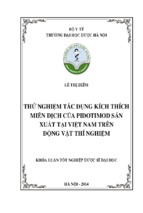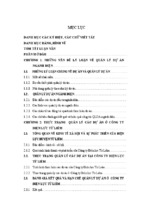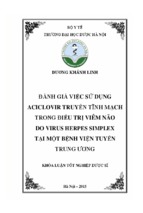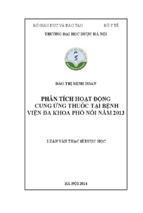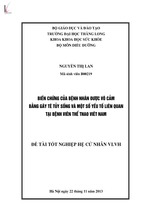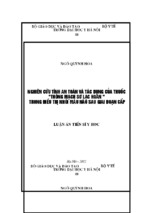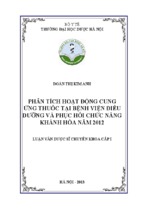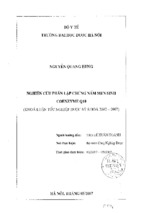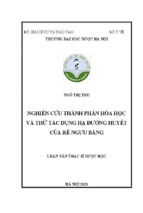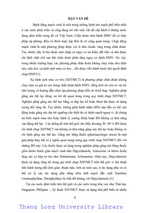UMEÅ UNIVERSITY MEDICAL DISSERTATIONS
New Series No. 990 ISSN 0346-6612 ISBN 91-7305-958-7
From Epidemiology and Public Health Sciences, Department of Public Health and Clinical Medicine,
Umeå University, SE-901 87 Umeå, Sweden
The injury poverty trap in rural Vietnam:
Causes, consequences and possible solutions
Nguyen Xuan Thanh
UmeМ 2005
Epidemiology and Pubic Health Sciences
Department of Public Health and Clinical Medicine
Umeå University, Umeå, Sweden
and
Department of Health Economics
Faculty of Public Health
Hanoi Medical University, Hanoi, Vietnam
Copyright : Nguyen Xuan Thanh
Photograph : Tran Thanh Do
Printed in Sweden by Print & Media, 2005
Epidemiology and Public Health Sciences,
Department of Public Health and Clinical Medicine
Umeå University, SE-901 87 Umeå
Abstract
The focus of this study is the vicious circle of poverty and ill-health. The case is
injuries but it could have been any lasting and severe disease. Poverty and health
have very close links to economic development and to how health care is
financed. Out-of-pocket payment seems to increase the risk of poverty while
prepaid health care reduces it. The overall objective is to investigate the “injury
poverty trap” and suggest possible solutions for it. A cohort of 23,807 people
living in 5,801 households in Bavi district of Vietnam was followed from 1999 to
2003 to investigate income losses caused by non-fatal unintentional injuries in
2000 as well as the relationships between social position in 1999 and those
injuries. For the possible solutions, a survey in 2064 household was performed to
elicit people’s preferences and willingness to pay for different health care
financing options. The results showed that unintentional injuries imposed a
large economic burden on society, especially on the victims. By two pathways –
treatment costs and income losses – unintentional injury increased the risk of
being poor. The losses for non-poor and poor injured households were about 15
and 11 months of income of an average person in the non-poor and poor group,
respectively. Furthermore, poverty was shown to be a probable cause of non-fatal
unintentional injuries. Specifically, poverty led to home injuries among children
and the elderly, and adults 15 – 49 years of age were particularly at risk in the
workplace. The middle-income group was at greatest risk for traffic injuries,
probably due to the unsafe use of bicycles or motorbikes. About half of the
population preferred to keep an out-of-pocket system and the other half preferred
health insurance. People’s willingness to pay suggested that a community-based
health insurance scheme would be feasible. However, improvements in the
existing health insurance systems are imperative to attract people to participate in
these or any alternative health insurance schemes, since the limitations of the
existing systems were generalized to health insurance as a whole. A successful
solution should follow two tracks: prepayment of health care and some insurance
based compensation of income losses during the illness period. If the risk of
catastrophic illness is more evenly spread across the society, it would increase the
general welfare even if no more resources are provided.
Key words: unintentional injury, poverty, out-of-pocket payment, health insurance,
Vietnam.
i
Acknowledgement
My gratitude to organizations as well as individuals mentioned in these lines is
much more than I can say. The word “thanks” looks larger than other words
since it has been fully loaded with my gratitude. There is, regrettably, still not
enough room…
This thesis has been completed through the contributions and support of many
people from the Hanoi Medical University, the Faculty of Public Health, the
Department of Health Economics, the Health Systems Research Project, the
FilaBavi in Vietnam and the Umeå International School of Public Health in
Sweden. My great thanks go to them for their contributions and support.
I would like to express my thanks particularly to:
- Ass. Prof. Ton That Bach, my late respectable teacher, a famous surgeon,
who has been considered as my second father since refusing my death from
a road accident in 1993. In my mind, he is always an idol, who sheds
much more light on my steps to the future.
- Ass. Prof. Nguyen Thi Kim Chuc, my supervisor, for enabling me to carry
out studies and providing me with good opportunities and valuable advice.
- Ass. Prof. Lars Lindholm, my main supervisor, for enriching my
knowledge, sharing with me not only scientific issues but also
commonplace things in life. His friendship makes me feel warm even in
the Umeå winters.
- Anders Emmelin, my supervisor, for his epidemiological guidance and
comments.
- Hoang Minh Hang, PhD; Curt Lofgren, BA; Prof. Peter Byass; and Niklas
Rudholm, PhD, my co-authors for their great technical contributions.
- Prof. Nguyen Lan Viet and Prof. Stig Wall, deans of the Hanoi Medical
University and the Umeå International School of Public Health
respectively for their great support.
- Edward Fottrell for checking English in the thesis.
ii
- Birgitta Åström for formatting the thesis and her logistical support during
the time I have spent in Umeå.
- Anna-Lena Johansson, Karin Johansson, Jerzy Pilch, Hans Stenlund and
other staff in the Umeå International School of Public Health for their
help and support.
- Nguyen Binh Minh, Vuong Lan Mai and other staff in FilaBavi for their
valuable contributions to the field work.
I also wish to express my thanks to my family and my friends in Vietnam for
encouraging and helping me overcome all difficulties faced in life.
This research was financially supported by the Sida/SAREC through the Health
Systems Research Programme in Vietnam and Umeå International School of
Public Health in Sweden.
iii
Table of content
ABSTRACT....................................................................................................................................................... i
ACKNOWLEDGEMENT...............................................................................................................................ii
TABLE OF CONTENT.................................................................................................................................. iv
ORIGINAL PAPERS ..................................................................................................................................... vi
ABBREVIATION ..........................................................................................................................................vii
CHAPTER 1. INTRODUCTION ................................................................................................................... 1
1.1. INJURIES AND COSTS ............................................................................................................................... 1
1.2. LACK OF PREPAID HEALTH CARE CAUSES A POVERTY TRAP ..................................................................... 3
1.3. THE RELATIONSHIP BETWEEN POVERTY AND INJURIES IN VIETNAM ........................................................ 4
1.4. CAN PREPAID HEALTH CARE PROTECT AGAINST THE POVERTY TRAP? ..................................................... 5
1.5. CONCEPTUAL FRAMEWORK ..................................................................................................................... 7
1.6. OBJECTIVES............................................................................................................................................. 8
CHAPTER 2. VIETNAM................................................................................................................................ 9
2.1. GEOGRAPHY ............................................................................................................................................ 9
2.2. DEMOGRAPHY ....................................................................................................................................... 10
2.3. ECONOMIC CONDITIONS ........................................................................................................................ 10
2.4. POVERTY ............................................................................................................................................... 12
2.5. HEALTH STATUS .................................................................................................................................... 13
2.6. HEALTH SYSTEM ................................................................................................................................... 15
2.7. HEALTH CARE FINANCING ..................................................................................................................... 17
CHAPTER 3. METHODOLOGY ................................................................................................................ 21
3.1. STUDY SETTING ..................................................................................................................................... 21
3.2. FILABAVI .............................................................................................................................................. 23
3.3. METHODS FOR INVESTIGATING INJURIES ............................................................................................... 24
3.4. METHODS FOR COSTING ........................................................................................................................ 26
3.5. METHODS FOR INVESTIGATING RELATIONSHIP BETWEEN INJURIES AND POVERTY ................................ 27
3.5.1. Do non-fatal unintentional injuries increase the risk of being poor?........................................... 27
3.5.2. Does poverty lead to non-fatal unintentional injuries? ................................................................ 29
3.6. METHODS FOR ELICITING PEOPLE’S PREFERENCES FOR DIFFERENT HEALTH CARE FINANCING OPTIONS 29
3.7. METHODS FOR ELICITING PEOPLE’S WILLINGNESS TO PAY FOR HEALTH INSURANCE ............................. 33
3.8. QUALITY CONTROL ............................................................................................................................... 34
3.9. ETHICAL CLEARANCE ............................................................................................................................ 34
CHAPTER 4. METHODOLOGY CONSIDERATION ............................................................................. 35
4.1. INJURY INVESTIGATION ......................................................................................................................... 35
4.2. INJURY COST ESTIMATION ..................................................................................................................... 36
4.3. POVERTY CLASSIFICATION .................................................................................................................... 39
4.4. DESIGN .................................................................................................................................................. 40
4.5. ELICITATION OF PEOPLE’S PREFERENCES FOR DIFFERENT HEALTH CARE FINANCING OPTIONS............... 42
4.6. ELICITATION OF PEOPLE’S WILLINGNESS TO PAY FOR HEALTH INSURANCE. .......................................... 43
CHAPTER 5. THE INJURY POVERTY TRAP: CAUSES AND CONSEQUENCES ........................... 46
5.1. COSTS OF NON-FATAL UNINTENTIONAL INJURIES .................................................................................. 46
5.1.1. Total costs..................................................................................................................................... 46
5.1.2. Cost distribution ........................................................................................................................... 47
5.1.3. Economic burden on household.................................................................................................... 49
5.2. DO NON-FATAL UNINTENTIONAL INJURIES INCREASE THE RISK OF BEING POOR?................................... 50
iv
5.2.1. Relationship between non-fatal unintentional injuries and SES mobility ................................. 50
5.2.2. Relationship between non-fatal unintentional injuries and income loss ................................... 50
5.3. DOES POVERTY LEAD TO NON-FATAL UNINTENTIONAL INJURIES?...................................................... 53
CHAPTER 6. THE INJURY POVERTY TRAP: POSSIBLE SOLUTIONS ....................................... 58
6.1. PEOPLE’ PREFERENCES FOR DIFFERENT HEALTH CARE FINANCING OPTIONS ....................................... 58
6.1.1. People’s preferences ................................................................................................................. 58
6.1.2. Determinants of people’s preferences ....................................................................................... 60
6.2. PEOPLE’S WILLINGNESS TO PAY FOR HEALTH INSURANCE .................................................................. 64
6.2.1. People’s willingness to pay ....................................................................................................... 64
6.2.2. Determinants of people’s willingness to pay ............................................................................. 66
CHAPTER 7. POLICY IMPLICATION.................................................................................................. 69
7.1. INJURY PREVENTION?......................................................................................................................... 69
7.2. POVERTY PATHWAYS? ....................................................................................................................... 69
7.3. ECONOMIC GROWTH – REDUCING POVERTY AND INJURIES OR WIDENING GAPS? ................................ 70
7.4. HEALTH INSURANCE FOR ALL?........................................................................................................... 72
7.5. SOCIAL MANDATORY OR PRIVATE VOLUNTARY?................................................................................ 72
7.6. HEALTH INSURANCE MANAGEMENT? ................................................................................................ 73
REFERENCES ........................................................................................................................................... 75
APPENDIX.................................................................................................................................................. 86
v
Original papers
I. Thanh NX, Hang HM, Chuc NTK, Lindholm L. The economic burden of
unintentional injury: a community-based cost analysis in Bavi, Vietnam.
Scandinavian Journal of Public Health 2003; 31(Suppl. 62): 45 – 51.
II. Thanh NX, Hang HM, Chuc NTK, Byass P, Lindholm L. Does poverty
lead to non-fatal unintentional injuries in rural Vietnam? International
Journal of Injury Control and Safety Promotion, Vol. 12, No. 1, March 2005,
31 – 37.
III. Thanh NX, Hang HM, Chuc NTK, Rudholm N, Emmelin A, Lindholm L.
Does “the injury poverty trap” exist? A longitudinal study in Bavi, Vietnam.
Health Policy (in press).
IV. Thanh NX, Lofgren C, Chuc NTK, Rudholm N, Emmelin A, Lindholm L.
People’s preferences for health care financing options: a choice experiment
in rural Vietnam. Health Policy and Planning (re-submitted).
V. Lofgren C, Thanh NX, Chuc NTK, Emmelin A, Lindholm L. People’s
willingness to pay for health insurance in rural Vietnam (manuscript).
The original papers are printed in this thesis with permission from the publishers
(http://www.tandf.co.uk).
vi
Abbreviations
ADB
AIDS
ARI
BMI
CDD
CHI
CHS
CI
Coef
CV
CVM
DPT
EPI
FilaBavi
GDP
GSO
HC
HCFP
HH
HI
HIV
IMF
MCH/FP
MOH
MOLISA
NOMESCO
OOP
OR
P
RR
SES
SAREC
Sida
TB
TV
UNDP
VHI
WB
WHO
WTP
Asean Development Bank
Acquired Immunodeficiency Syndrome
Acute Respiratory Infection
Body Mass Index
Control of Diarrhoeal Disease
Compulsory Health Insurance
Communal Health Station
Confidence Interval
Coefficient
Contingent Valuation
Contingent Valuation Method
Diphtheria, Pertussis, Tetanus
Expanded Programme on Immunization
Epidemiological Field Laboratory in Bavi District
Gross Domestic Product
General Statistics Office
Health Care
Health Care Funds for the Poor
Household
Health Insurance
Human Immunodeficiency Virus
International Monetary Fund
Maternal and Child Health/Family Planning
Ministry of Health
Ministry of Labour, Invalid and Social Affairs
Nordic Medico-Statistical Committee
Out-of-pocket payment
Odds Ratio
P-value
Relative Risk
Socio-Economic Status
Swedish Agency for Research Cooperation with Developing
Countries
Swedish International Development Cooperation Agency
Tuberculosis
Television
United Nations Development Programmes
Voluntary Health Insurance
World Bank
World Health Organization
Willingness to pay
vii
Introduction
Chapter 1. Introduction
The focus of this study is the vicious circle of poverty and ill-health. The case is
injuries and their consequences but it could have been any lasting and severe
disease. Poverty and health have very close links to economic development and to
how health care is financed. Out-of-pocket payment seems to increase the risk of
poverty while prepaid health care reduces it. In reality, however, it is not easy to
have a successful prepaid scheme in developing countries such as Vietnam. The
success of such a system is dependent on a range of determinants. An important
determinant that should be firstly mentioned is support for or at least acceptance
of the system by the population. In the following each of the issues mentioned
above will be further discussed.
1.1. Injuries and costs
Throughout the world, injuries have become a major public health problem in
terms of health and economic burden. An estimated 5 million people worldwide
1
died from injuries in 2000 — a mortality rate of 83.7 per 100,000 population.
For every person that dies, several thousands more are injured, many of them
with permanent sequelae of injuries. Injuries occur in all regions and countries,
2
and affect people in all age and income groups. The magnitude of the problem,
however, varies considerably by age, sex, region and income group. For example,
in the low and middle-income countries in the Western Pacific, the leading
injury-related causes of death are road traffic injuries, drowning and suicide,
while in Africa they are war, interpersonal violence and traffic injuries.
Analyses show that there are very few countries where unintentional injuries do
not appear among the five leading causes of death. In the American continent in
particular, unintentional injuries are among the five leading causes of death in all
countries, whatever their level of development. In the United States, for example,
unintentional injuries are the leading cause of death for people aged 1 to 34. Each
year, more than 90,000 people die in the United States as a result of
unintentional injuries. During an average year in the United States, unintentional
injuries account for nearly 31 million emergency room visits.3
How large is the injury problem in low-income countries such as Vietnam? It is
very difficult to give an adequate picture of injuries in Vietnam because, so far,
there are neither comprehensive injury register systems nor research about
frequencies and consequences of injuries. However, since 1986, the year when
the liberalization of the economy started (“Doi Moi”), the injury pattern in
1
Introduction
4
Vietnam has been reported to change. This is especially clear for traffic injuries.
From 1988 to 1997 traffic accidents increased fourfold to 19,159. Police statistics
showed that fatal accidents soared by almost 235% and injuries by 400%. Traffic
accidents increased from 7.1 per 1000 inhabitants to 24.9, fatalities rose from 3.9
to 7.4, and injuries from 8.7 to 28.4, giving Vietnam one of the highest traffic
accident rates in the world.5 The trends seem to continue. In 2001, about 58
people died daily on the roads in Vietnam and almost double the deaths were the
numbers of injury-causing accidents. Especially among children, in the same year,
4,100 children were reported to have died from traffic accidents, equivalent to 11
children a day (Boys were twice as likely to die as girls), and 290,000 were
6
injured, equivalent to 794 a day.
Picture 1. Heavy traffic in Vietnam.
Injuries are not only the leading cause of death and disability, but also a great
financial burden on the economy of each country. For example, in the United
States, injuries continue to impose a multibillion-dollar burden on the economy,
7
as reported by Miller and Lestin. Medical spending on injuries in 1987 was USD
64.7 billion in 1993 dollars or 8.3% of 1993’s total health care spending in the
2
Introduction
United States. Non-hospital medically treated injuries averaged USD 571 in
medical spending per case, or USD 181 per visit. If medical cost was estimated
together with costs for rehabilitation and income loss, the costs of injury would
8
be more than USD 224 billion in year 2000. In reality, the consequences of
unintentional injuries for health care are tremendous and probably greatly underestimated by the public and by decision-makers. Unintentional injuries are a
major cause of demands on the health system, both at the primary health care
level and the hospital level. On average in developed countries, and also in many
developing countries, one hospital bed out of ten is occupied by an unintentional
2
injury victim.
In a country without comprehensive injury register systems, such as Vietnam,
very little is known about injury costs. Therefore, “How large is the economic
burden of injuries and how does the burden distribute among households, the
government and insurance agencies?” is the first issue being investigated in this
study.
1.2. Lack of prepaid health care causes a poverty trap
Health care financing solutions around the world are heterogeneous. In
developed countries almost all health care is prepaid. In Western Europe taxes
and social insurance are most common and most important. In the US, private
insurance has a prominent position but is complemented by tax financed health
care for the poorest. In developing countries out-of-pocket is a very common
financing source, and Vietnam is no exception. Rather, Vietnam is among the
countries in the world that have the smallest proportion of prepaid health care.
The absence of prepaid health care was addressed in the report of the
Commission on Macroeconomics and Health.9 They conclude that the economic
consequences of a disease episode, or ill health caused by injuries, on an
individual household can be magnified because the cost of dealing with the
illness, in the absence of insurance, forces a household to spend so much of its
resources on medical care that it depletes its assets and debts are incurred. This
may throw a household into poverty from which it cannot escape, and which has
ramifications for the welfare of all its members and often of relatives as well. Poor
households in developing countries are rarely insured against catastrophic
injuries, and are therefore often required to sell their few assets, such as farm
equipment and animals, or to mortgage their land, in order to maintain minimal
consumption in the face of lost market earnings and to pay for urgent medical
care. This depletion of productive assets can lead to a poverty trap (i.e. persisting
poverty) at the household level even after the acute illness is overcome, since
impoverished households will have a hard time re-capitalizing their productive
3
Introduction
activities. The indebted household will lack the working capital to make the
short-term investments (e.g. in seed, fertilizer) to produce sufficient output to pay
off the debts, and will be unable to borrow against future earnings. The poverty
in turn may intensify the original disease conditions as well.
10
Furthermore, Whitehead et al argue that two global trends – the introduction of
user fees for public services, and the growth of out-of-pocket expenses for private
services – together constitute a major poverty trap. They identify four main
categories of effects of the medical poverty trap: untreated morbidity; reduced
access to care; long-term impoverishment; and irrational use of drugs. The first
three hardly require any explanations, but regarding drugs they argue that in
many low-income countries drugs are sold out-of-pocket without any
prescription by unqualified people who have financial incentives to sell as much
as possible. The consequences will be an overuse of drugs, not motivated by the
medical condition and sometimes even hazardous for the patient’s health.
This phenomenon has been observed in developing countries, for instance China
11
and Cambodia. According to a household survey in rural China, high medical
expenses (user fees and payment for drugs) are the main reason for becoming
poor today. It causes a greater threat for driving people into poverty than
12
unemployment and poor harvests. A study in Cambodia shows that consultation
fees charged by private providers increased in tandem with price increases
introduced at the referral hospital. It further demonstrates that the introduction
and subsequent increase in user fees created a “medical poverty trap”, which has
significant health and livelihood impacts including untreated morbidity and
long-term impoverishment.
1.3. The relationship between poverty and injuries in Vietnam
What is known about the problem in Vietnam? Not much, but there are some
reasons to expect that the problem is significant and increasing. Before 1989,
Vietnamese health care was financed mainly from two sources: mostly from the
national revenue and a small part from foreign donors. Health care services were
used free of charge. Since the transition to market economy started, public
contribution has decreased substantially while the importance of user fees has
grown. This policy has generated more resources for the health sector thereby
13
increasing the quality of health care services. However, the policy has also had
some negative effects, especially regarding the poor’s access to health care
14,15,16,17
services.
When the poor get ill or injured they usually treat themselves.
When the health consequences are serious and medical treatment is absolutely
4
Introduction
unavoidable, people have to borrow money and/or sell assets in order to afford
the user fees.
Financial contribution to the health care system by different income groups is
frequently studied, and the main findings of these studies is that the Vietnamese
system is regressive, i.e. that lower income groups pay a larger fraction of their
18,19,20,21
income to health care than groups with higher income.
In a recent study,
Thuan22 showed that the households health care expenditure was 5.0% in the
group with the highest income and 8.4% in the group with the lowest income.
Considering the fact that the income was three times larger in the “high-income”
group, it is obvious that they can afford both more and better health care.
However, the average proportion paid in different income classes is only one side
of the coin since the random nature of disease and injuries makes it highly likely
that people in the same income group will pay very different amounts. People
free from disease and injuries will pay nothing while those more unfortunate who
are affected by catastrophic illness have to pay enormous amounts.
23
A recent cross-sectional participatory poverty assessment in Vietnam identified
the economic shock of ill health as the most common cause of household
poverty. Around 3 million people are driven into poverty each year as a result of
meeting health care payments – a 4% rise in the poverty headcount in 1993 and
24,25
3.4% in 1998.
This process may be accelerated by the fact that the risk of
injures is not likely to be independent of poverty, as shown in Swedish studies,26
27
28
an English study and an American study. This social gradient in injury risk will
probably be found in developing countries as well. People living under harsh
conditions are certainly willing, or forced, to accept jobs that expose them to
extremely high risks and their housing and traffic environments are often very
risky, for instance.
The relationship between injuries and poverty has not been longitudinally
investigated in empirical studies in Vietnam. There may be a vicious circle:
poverty increases the risk of injuries, injuries require high medical expenditure
and cause losses of earnings that may throw people into poverty, thereby further
increasing the risk of injuries and poverty-related diseases etc. These are the
second and third issues being investigated in this study.
1.4. Can prepaid health care protect against the poverty trap?
The consequences and extension of the injury poverty trap can be alleviated in
different ways. One is of course the prevention of injuries. The Ministry of
Health of Vietnam has initiated a national programme on injury prevention and
5
Introduction
safe communities since 1996. Reportedly, the programme has initially achieved
29
remarkable results, although further studies and improvements are needed.
Another way to reduce the consequences is through health care financing
reforms. Disease and injury poverty traps will exist and be unavoidable in all
systems with a high proportion of out-of-pocket payment. Public or private
prepayment models are needed to eliminate the traps because by such models,
financial risk will not be only spread over time, but also pooled across the
12,30,31,32
population.
There are two common types of health insurance in the world. They are health
insurance based on community rating and health insurance based on risk
33,34
rating. Community rating means that people cannot be discriminated against
in obtaining health insurance on the basis of health risk. It requires that in setting
premiums, or paying benefits, insurers cannot discriminate between contributors
on the basis of health status, age, race, gender, use of hospital or medical services,
or general claims history.35,36 Conversely, risk rating means premiums are high or
low depending on health risks of the insured. If you are old and have some
chronic disease, you have to pay a premium higher than a young person free from
disease. This type of health insurance is common in the US, while community
rating health insurance is common in European countries. Both types have their
own strong and weak points, depending upon different perspectives. For
example, an American article37 argues that community rating would increase the
number of uninsured because it involves raising the premiums of healthy
individuals in order to subsidize the premiums of those at high risk.
Subsequently, as sick people enter the market, causing costs (and, therefore
premiums) to rise, healthy people leave. While a document from Ireland - an
38
European country considers that is a strong point of community rating because
it makes disadvantage group (old, sick, poor…) affordable for health insurance.
In Vietnam, a health insurance policy has been implemented since 1992 and the
premiums have contributed to an increasing proportion of a very limited health
39
care budget. In addition, health insurance enables poor people to access health
care and thus indirectly contributes to the preliminary success of the “hunger
elimination and poverty reduction” policy of the Vietnamese government in
recent years. Today, however, the majority of health care financing is through
out-of-pocket payment and health insurance coverage remains very low. By 2002,
only 16.5% of about 80 million Vietnamese were insured, mostly in the form of
40
compulsory insurance for salaried employees. The goal of the Vietnam
Government and Vietnam Health Insurance is “health insurance for all by the
41
year 2010”. However, the ways to achieve this goal, including which health
6
Introduction
insurance scheme should be applied, have not been adequately studied. An
appropriate scheme should receive support or at least acceptance and a
willingness to pay among the Vietnamese population. Therefore, people’s
preferences and willingness to pay for different health care financing systems are
the forth and the fifth issues being investigated in this study, in order to suggest a
health care financing system in line with people’s desires.
1.5. Conceptual framework
Figure 1. The injury poverty trap and possible solutions
Injury Poverty Trap
Possible Solution
III
Health insurance:
- Preferences (IV)
- WTP (V)
Costs:
- Health care cost
- Production loss
Poverty:
- Can’t escape
- Drop into poverty
- Income loss
I
II
Unintentional
injuries
7
Introduction
1.6. Objectives
1.6.1. Overall objective:
The overall objective of the study is to investigate the “injury poverty
trap” and suggest possible solutions for the trap in a rural district in
Vietnam.
1.6.2. Specific objectives:
• To estimate the economic burden of non-fatal unintentional
injuries and describe how the burden is distributed among
households, the government and insurance agencies (paper I).
• To longitudinally investigate the relationships between non-fatal
unintentional injuries and poverty: Do non-fatal unintentional
injuries increase the risk of being poor? (paper III); and does
poverty lead to non-fatal unintentional injuries? (paper II)
• To elicit and analyze people’s preferences (paper IV) for
different health care financing options: out-of-pocket payment,
compulsory health insurance based on community rating, and
voluntary health insurance based on risk rating.
• To elicit and analyze people’s willingness to pay (paper V) for
joining in different health insurance schemes: compulsory health
insurance based on community rating, and voluntary health
insurance based on risk rating.
8
Vietnam
Chapter 2. Vietnam
2.1. Geography
Vietnam is a long and narrow
country extending along the eastern
edge of the Indochina Peninsula,
facing the Gulf of Tonkin and the
South China Sea. The coastline is
over 3,000 km long and the land
borders extend over 3,700 km
(sharing 1,160 km with China,
1,650 km with Laos and 930 km
with Cambodia). It has a total
42
surface area of 331,100 km2.
Vietnam is situated in the tropics, in
the centre of South-East Asia. It is
closer to the Tropic of Cancer than
to the Equator. Its subsoil contains
most of the minerals essential to
industrialization: petroleum, coal,
iron, tin, bauxite, copper, chrome,
apatite, etc. Arable land covers 6.5
million hectares of the country. The
cultivation of rice, cereals, and fruits,
takes place in the vast and fertile
plains around the Red and Mekong
River Deltas, while cash crops such
as coffee, tea and rubber are
concentrated in the hill areas and
plateaus.
Source: CIA 2005.43
9
Vietnam
Vietnam has four distinct seasons with noticeably different climates. Also due to
the length of the country, weather patterns vary from region to region. Winter
lasts from November to January in the north, January being the coldest month,
when the mean temperature drops below 15 degrees centigrade. Winter is
normally characterized by fine drizzle that is damp and penetrating. The centre
Vietnam also undergoes cooler temperatures during these months but they do
not last as long as in the north. However, the mean temperature in the south does
not drop below 25 degrees centigrade. The spring lasts for about three months
(February-April) with the temperature between 18 and 22 degrees centigrade in
the north, and already up to 30 degrees centigrade, the peak mean temperature,
in the south. April can bring heavy rainfall to the north, noticeably drier weather
to central areas, and scorching heat to the south. The summer in the north lasts
from May to July when the temperature is also at its highest (30-40 degrees
centigrade) and, surprisingly, the temperature in the north is hotter than the in
the south. Typhoons are frequent during this period. Starting in August, the fall
sets in with cool weather and temperatures of about 20 degrees. At this time the
season of heavy rains and typhoons commences in central Vietnam. Annual
rainfall averages about 1,830 mm with high humidity (85-88%) throughout the
year.
2.2. Demography
The twelfth most populous country in the world, Vietnam has a population
43
estimated at 83,535,576 and a population growth rate at 1.04% in 2005. The
two most populated regions are the deltas of the Red River (north) and Mekong
River (south). Ethnic Vietnamese (Kinh) make up 85% of the population, a
mixture of over 50 ethno-linguistic groups make up 12% and ethnic Chinese
comprise the remaining 3%.
Vietnamese is the national language and is spoken by over 80% of the
population. The ethnic minorities of the mountainous regions, while preserving
their own languages, also speak and study Vietnamese. The majority of
Vietnamese practice Buddhism. Other religions include Confucianism, Taoism,
Christianity, Animism, Cao Daism, Hoa Hao and Islam.
2.3. Economic Conditions
Vietnam has been transitioning from a centrally planned economy to a socialistoriented market economy since the economic reforms in 1986, known as Doi
Moi (renovation). The Doi Moi with market liberalization and decentralization
policies has dramatically transformed the country. Over the last ten years Gross
10
- Xem thêm -


